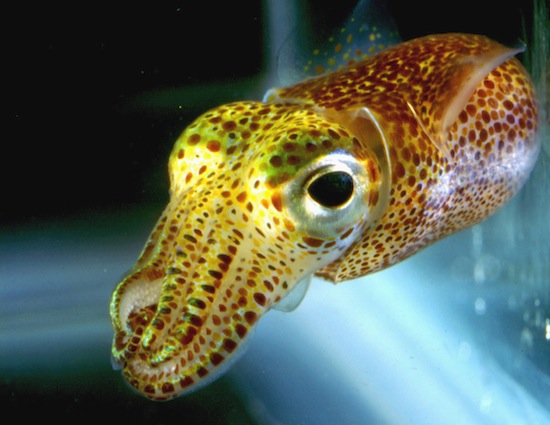Microbe shown to regulate its host’s biological clock

The Hawaiian bobtail squid seems to have its biological rhythms regulated by a symbiont bacterium, according to new UW–Madison research.
Photo: William Ormerod/courtesy Margaret McFall-Ngai
At a time when scientists are beginning to recognize the pervasive influence of microbes in a legion of plant and animal functions, new research shows a symbiotic bacterium setting the biological clock of its host animal.
The research, published online in the journal mBio, is the first to show that a microbe, in this case a bioluminescent bacterium known as Vibrio fischeri, regulates a daily rhythm of its host, the Hawaiian bobtail squid. The work is important because it hints at a deeper and more extensive biological interplay between host organisms and the microbes that are ubiquitous companions and symbionts to all plants and animals, including humans.
The new study, conducted by a group led by Margaret McFall-Ngai of UW–Madison, reveals that the light generated by the colonizing bacterium triggers a genetic cascade in the cells of the squid light organ, which, in turn, control the daily cycle of biological activity typically synchronized by environmental cues such as sunlight.
“Instead of environmental light, this animal responds and cycles in response to the luminescence from its own light organ,” explains McFall-Ngai, a professor of medical microbiology and an authority on the bobtail squid and its luminescing symbiotic bacterium.
Circadian rhythm in humans and other animals is governed by an internal or “biological clock” with a cycle of about 24 hours and seems to be regulated largely by exposure to light and darkness. It is responsible for sleep cycles and other physiological and metabolic functions. Its most visible manifestations in humans occur in things like jet lag and the effects of night work shifts. Disrupting the daily cycle can have serious health consequences, including sleep and immune system disorders, and conditions like seasonal affective disorder.
At the molecular level, circadian rhythm is driven by a set of “clock genes” and their relatives, according to McFall-Ngai.
“This animal has a light-producing system in an organ in the middle of the body,” says McFall-Ngai. “The bacteria in the light organ are luminous, and their luminescence affects the expression of a clock gene known as ‘cry’ in the cells of the light organ that are interacting with these luminous bacteria.”
The squid spends its nights foraging near the ocean surface. It uses the light organ as a sort of cloaking device to fool predators lurking below. At daybreak, it expels or vents 90 percent of the glowing bacteria and burrows into the sand where it can safely sleep until nightfall when, with a new crop of bacteria, it resumes its nocturnal foraging.
In the squid, the daily cycling of the cry genes found in the cells of the light organ are triggered by the light from the colonizing luminescent bacteria, making it a neat model to understand the interplay of a symbiont bacterium and the biological functions of its host.
“In humans, the genes expressed in the gut are on a profound circadian rhythm run by the clock genes,” notes McFall-Ngai. “Everything in the human gut is on a rhythm. Perhaps the thousands of bacteria there also govern the rhythms of the gut, just as the luminous bacteria partner of the squid sets the rhythms in the light organ.
“In the squid, we have one host and one microbe, and we can manipulate the microbe genetically and the whole system experimentally, which provides much more resolution than can be done in studies of the human gut.”
McFall-Ngai and her colleagues assessed the expression of the cry gene with and without bacteria present, and also with mutant bacteria incapable of producing light. Their results showed for the squid’s clock genes to be expressed in a rhythm, light from the bacterium is required.
While the study adds insight into the importance of biological rhythms for an animal’s well being, the most astonishing insight is that an animal’s circadian rhythm and the molecular switches that control it can be governed by a symbiotic microbe. Says McFall-Ngai: “We’re beginning to realize that circadian rhythms are really important for health and that microbes are important for everything.”
Co-authors of the new study include Elizabeth A.C. Heath-Heckman and Suzanne M. Peyer, also of UW–Madison; Cheryl A. Whistler of the University of New Hampshire; Michael A. Apicella of the University of Iowa; and William E. Goldman of the University of North Carolina, Chapel Hill. The research, published in the (DATE) edition of the journal mBio, was supported by the National Institutes of Health (RO1-RR12294, RO1-AI50661) and the National Science Foundation (IOS 0517007, IOS 0715905).
Tags: biosciences, microbiology, research



